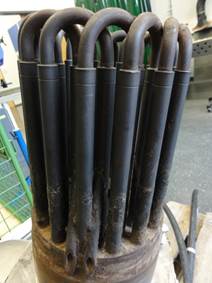Stirling Engine
CHP with a biomass-fueled Stirling engine
In the past few years, efforts have been made to develop micro- and mini-CHP systems based on solid biomass fuels, but many of them failed to provide high-temperature heat for thermal engines.
For the use of solid biomass, the robust and externally continuously heated Stirling engine can be used. The core problem of this concept, however, is the design of the furnace. High combustion temperatures in conjunction with low ash melting temperatures inevitably lead to the formation of slagging on the heating surfaces, which reduces the heat transfer and increases the maintenance effort. This mechanism is usually encountered only by reducing the combustion temperatures due to an increased air excess, but with reduced electrical efficiency. The use of conventional combustion systems is thus less suitable for this purpose.
Within the scope of this research focus, the aim of the Chair for Energy Process Engineering was to develop a combustion system based on fluidised bed combustion, which is tailored to the three essential requirements:
- Optimum heat transfer to the heater head of the Stirling engine
- Minimum emissions to comply with legal pollutant limits
- Compact design comparable to previous combustion systems
After preliminary investigations with a 3 kWel Stirling engine on a 100 kW fluidised bed combustion, a fluidised bed combustion system has been specially developed and built up for this purpose in recent years. This shows that relevant levels of efficiency can already be achieved and at the same time the emissions of CO and dust are also below the legal limit values.
Currently, the focus is on the further development of this plant concept as a long-lasting pilot plant.
Contact:
Prof. Dr.-Ing. Jürgen Karl
Department of Chemical and Biological Engineering
Lehrstuhl für Energieverfahrenstechnik
- Phone number: 09115302-99021
- Email: juergen.karl@fau.de


